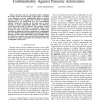656 search results - page 77 / 132 » Scheduling Nodes in Wireless Sensor Networks: A Voronoi Appr... |
WD
2010
13 years 6 months ago
2010
Gossip-based epidemic protocols are used to aggregate data in distributed systems. This fault-tolerant approach does neither require maintenance of any global network state nor kno...
CORR
2008
Springer
13 years 9 months ago
2008
Springer
Resource and cost constraints remain a challenge for wireless sensor network security. In this paper, we propose a new approach to protect confidentiality against a parasitic adver...
CN
2004
13 years 8 months ago
2004
Wireless Sensor Networks (WSN) are characterized by the dense deployment of sensor nodes that continuously observe physical phenomenon. Due to high density in the network topology...
AINA
2007
IEEE
14 years 3 months ago
2007
IEEE
Nodes in sensor fields and in autonomous swarms of mobile robots need to communicate; this usually requires individual nodes to either consume a significant amount of energy, ca...
MASS
2010
13 years 7 months ago
2010
Wireless sensor networks typically conserve energy by following a periodic wakeup-sleep schedule: nodes minimize idle time and spend most of their time in a low power sleep state. ...

